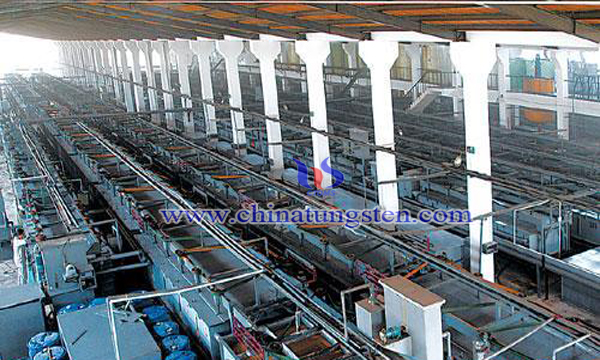Residual Alkali Recycle from Tungsten Smelting
- Details
- Category: Tungsten Information
- Published on Wednesday, 09 October 2019 23:48
Scheelite is a troublesome raw material in tungsten smelting. With the popularization of alkali pressure leaching technology in the last century, the production capacity and scale of scheelite smelting have been greatly improved, and the technology has been further mature. Because of the excessive alkali process, although most of the alkali is consumed in the leaching process, the residual alkali in crude sodium tungstate solution is still very high after the reaction.

Recovery of residual alkali from tungsten smelting is a process of evaporation, concentration and crystallization of solution, mainly energy consumption. However, most tungsten smelting enterprises will not consider recovery of residual alkali under the current situation of rising energy prices. After all, the economic benefit is very small. Recovery of residual alkali is necessary only when the concentration of residual alkali in solution exceeds 100 g/L. The simple process of recovery of residual alkali is as follows:
Sodium tungstate liquid from autoclave contains 100 g/L tungsten trioxide, 45 g/L sodium hydroxide and 5000 mL of solution volume. After liquid-solid separation by filter press, it is pumped into three-effect evaporative crystallizer. The steam pressure at the inlet of one-effect evaporative crystallizer is 0.4 MPa, the temperature is 155 ℃. Sodium tungstate crystals precipitated from two-effect evaporative crystallizer and three-effect evaporative crystallizer are fed to plate-frame pressure filter for solid liquid separation. Separation, filter return to pressure boiling process, filter residue dissolution and ion exchange process, condensate as the main process of dilution water, filtrate concentration of sodium hydroxide 385 g/L, tungsten trioxide 25.5 g/L. The direct recovery of tungsten and alkali is 97% and 96.8% respectively.
The technical points of the above process are as follows: the crude sodium tungstate solution with low residual alkali concentration must evaporate a large amount of water vapor in the solution. After further concentration, the solubility of sodium tungstate decreases rapidly and crystals precipitate when the alkali concentration increases. As the concentration continues, the solution viscosity increases, so in the design and layout of the three-effect evaporation crystallizer, the two-effect and three-effect crystallization will be vacuum-pumped, which can effectively reduce the boiling point temperature of the solution. Although the temperature of the one-effect regenerated steam is lower than that of the raw steam, the purpose of further concentration of the solution can also be achieved. Because the solubility of sodium tungstate decreases with the increase of alkali concentration, independent crystal outlets are set up in the two-effect and three-effect evaporation crystallizers, which prevents scaling and piping problems caused by large number of crystals precipitation in the two-effect crystallizers.
- Tungsten Manufacturer & Supplier, Chinatungsten Online: www.chinatungsten.com
- Tungsten News & Prices of China Tungsten Industry Association: www.ctia.com.cn
- Molybdenum News & Price: news.molybdenum.com.cn
- Tel.: 86 592 5129696; Fax: 86 592 5129797; Email: sales@chinatungsten.com



 sales@chinatungsten.com
sales@chinatungsten.com